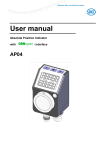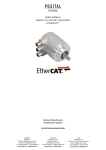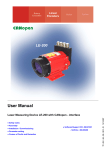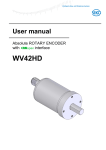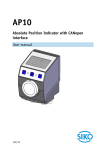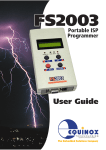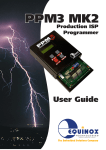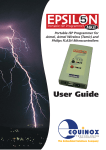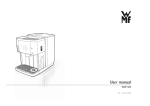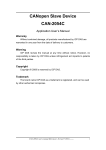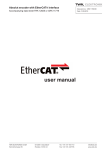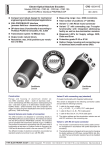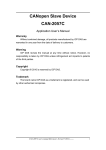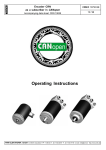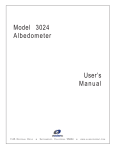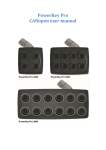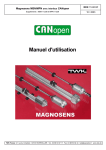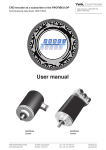Download R Series Encoders with CANopen Interface - TWK
Transcript
R Series Encoders with CANopen Interface RNX 11197 HE 11 / 2005 User Manual TWK-ELEKTRONIK GmbH · PB. 10 50 63 · D-40041 Düsseldorf · Tel.: +49/211/63 20 67 · Fax: +49/211/63 77 05 · [email protected] · www.twk.de COPYRIGHT: The RNX 11197 operating instructions are owned by TWK-ELEKTRONIK GMBH and are protected by copyright laws and international treaty provisions. © 2005 by TWK-ELEKTRONIK GMBH POB 10 50 63 ■ 40041 Düsseldorf ■ Germany Tel. +49/211 /63 20 67 ■ Fax +49/211 /63 77 05 [email protected] ■ www.twk.de RNX 11197 HE / Page 2 Table of contents 1. General ................................................................................................................................ 5 2. CANopen features of R Series encoders ......................................................................... 5 3. Installation instructions ..................................................................................................... 5 3.1 Electrical connection ....................................................................................................................5 3.2 Baud rates and lead lengths ........................................................................................................6 3.3 Setting the address and Baud rate ...............................................................................................6 3.4 EDS file ........................................................................................................................................6 4. Process data exchange ..................................................................................................... 7 4.1 Operating modes ..........................................................................................................................7 4.2 Data format...................................................................................................................................8 5. Emergency messages ........................................................................................................ 8 6. Programming and diagnosis (object directory)............................................................... 9 6.1 Overview of the object directory ...................................................................................................9 6.2 Communication parameters .......................................................................................................10 6.2.1 Object 1000h - Device type ......................................................................................................10 6.2.2 Object 1001h - Error register....................................................................................................10 6.2.3 Object 1005h - COB-ID SYNC .................................................................................................10 6.2.4 Object 1008h - Manufacturer device name ..............................................................................10 6.2.5 Object 1009h - Manufacturer hardware version .......................................................................10 6.2.6 Object 100Ah - Manufacturer software version ........................................................................10 6.2.7 Object 1010h - Store parameters ............................................................................................. 11 6.2.8 Object 1011h - Restore default parameters ............................................................................. 11 6.2.9 Object 1014h - COB-ID EMCY................................................................................................. 11 6.2.10 Object 1017h - Producer heartbeat time ................................................................................ 11 6.2.11 Object 1018h - Identity Object ................................................................................................ 11 6.2.12 Object 1800h - First transmit PDO .........................................................................................12 6.2.13 Object 1801h - Second transmit PDO ....................................................................................12 6.2.14 Object 1A00h - First transmit PDO mapping ..........................................................................12 6.2.15 Object 1A01h - Second transmit PDO mapping.....................................................................12 6.3 Standardised device parameters................................................................................................13 6.3.1 Object 6000h - Operating parameters......................................................................................13 6.3.2 Object 6001h - Measuring units per revolution ........................................................................13 6.3.3 Object 6002h - Total measuring range .....................................................................................13 6.3.4 Object 6003h - Preset value.....................................................................................................13 6.3.5 Object 6004h - Position value ..................................................................................................13 6.3.6 Object 6200h - Cyclic timer ......................................................................................................13 6.4 Standardised device diagnosis...................................................................................................14 6.4.1 Object 6500h - Operating status ..............................................................................................14 6.4.2 Object 6501h - Singleturn resolution ........................................................................................14 RNX 11197 HE / Page 3 Table of contents 6.4.3 Object 6502h - Number of distinguishable revolutions.............................................................14 6.4.4 Object 6503h - Alarms..............................................................................................................14 6.4.5 Object 6504h - Supported alarms ............................................................................................14 6.4.6 Object 6506h - Supported Warnings ........................................................................................15 6.4.7 Object 6507h - Profile and software version ............................................................................15 6.4.8 Object 6508h - Operating time .................................................................................................15 6.4.9 Object 6509h - Offset value .....................................................................................................15 6.4.10 Object 650Ah - Modul identification .......................................................................................15 6.4.11 Object 650Bh - Serial number ................................................................................................15 6.5 Manufacturer-specific parameters ..............................................................................................16 6.5.1 Object 2000h - Node ID ...........................................................................................................16 6.5.2 Object 2001h - Bit timing ..........................................................................................................16 7. Examples ........................................................................................................................... 17 7.1 Boot-up .......................................................................................................................................17 7.2 Change parameter .....................................................................................................................17 7.3 Setting the node address via LSS ..............................................................................................18 8. Literature ........................................................................................................................... 19 RNX 11197 HE / Page 4 1. General 2. CANopen features 3. Installation instructions 1. General The electromagnetic R Series encoders are designed for direct connection to the CAN bus. This is achieved internally via the CAN bus controller T89C51 CC02 SO 28 (Atmel). The following specifications have been implemented: Device Profile for Encoders CiA Draft Standard 406, Version 3.0 /1/ CANopen Application Layer and Communication Profile CiA Draft Standard 301, Version 4.02 /2/ The CANopen specifications can be obtained from the user organisation CiA (www.can-cia.org). The following R Series encoders with CANopen interface have been taken into consideration: Model designation Data sheet RNM/RNW 11397 Description Single-turn encoder 2. CANopen features of R Series encoders - According to device profile DS 406, version 3.0, Device Profile for Encoders /1/ - NMT slave - One SDO per communication direction for accessing the object directory - Two transmit PDOs - PDO identifier adjustable via SDO - SYNC message - EMERGENCY message - Simple boot-up according to DS 301 - Transmission types can be set for all PDOs - Node number and Baud rate setting via Layer Setting Service (LSS) /4/ 3. Installation instructions 3.1 Electrical connection CiA Draft Recommendation Proposal 303-1, Version 1.1.1 CANopen Cabling and Connector Pin Assignment /3/ must be adhered to when connecting the encoder. This particularly applies with regard to the terminal resistors, the lead characteristics, the length of the branch lines and the transmission length. The bus terminal resistors must be implemented internally. The precise connector assignment is enclosed with each device. Encoder CAN-Bus subscriber Principle bus structure: CAN_H CAN_H CAN-Bus * 120 CAN_L 120 * CAN_L * Terminal resistor RNX 11197 HE / Page 5 3. Installation instructions 3.2 Baud rates and lead lengths Baud rate [kBaud] Lead length [m] Note: 20 50 2500 1000 125 250 500 800 1000 500 250 100 50 25 (According to CiA DS 301) The encoder has no galvanic separation between the supply voltage and bus leads; the total bus length is therefore limited to 200 m. 3.3 Setting the address and Baud rate The node address (node number) and the Baud rate are set via the LSS - Layer Setting Service (see CiA DS 305). In this case, each node has a unique LSS address, via which it can be identified in the network. This is comprised of the following: Manufacturer ID: Product number: Revision number: Serial number: 0000 010Dh 0000 2000h 0001 0003h xxxx xxxxh (TWK manufacturer ID) (TWK product number) (current revision number) (relevant serial number of the sensor) See example in Chapter 7.3 In addition to the option of setting the node address and Baurate via the LSS, the parameters can also be changed via objects 2000h and 2001h (see manufacturer-specific object range, Chapter 6.5). The default values are: Baud rate: 20 kBaud Node address: 1 3.4 EDS file The EDS file is enclosed on a diskette in order to integrate the sensor into a project planning tool. This file clearly and completely describes the characteristics of the CANopen subscriber in a defined format. After integrating the EDS file into the project planning tool (e.g. CANsetter from Vektor-Informatik), the encoder‘s parameters can be comfortably set and diagnostic information can be read. RNX 11197 HE / Page 6 4. Process data exchange 4. Process data exchange In the case of CANopen, I/O data traffic takes place via the PDO (Process Data Object) message. The R-Series encoders provide two PDOs. Their transmission behaviour (transmission type) can be set independently of each other. 4.1 Operating modes The following operating modes can be set: Polling Mode (asynchronous-RTR): The encoder transmits the current, actual position value, after the current position value has been polled via a „Remote Frame“ message by the master. Asynchronous Mode (cyclic / acyclic): Without being requested to do so by the master, the encoder transmits the current, actual position value following a value change and following the expiry of a cyclic time (cyclic timer > 0). The cycle time can be parameterised for values between 1 ms and 65,535 ms. Synchronous Mode (synchronous-cyclic): After receiving a SYNC message transmitted by a master, the encoder transmits the current, actual position value. The encoder‘s SYNC counter can be parameterised in such a way that the position value is only transmitted following a defined number of SYNC messages. Acyclic Mode (synchronous-acyclic): After receiving a SYNC message, the encoder only transmits the current, actual position value if the position value has changed since the last transmission. In the case of CANopen, the operating modes (transmission types) and all other parameters are set via so-called SDOs (Service Data Object). The transmission types for PDO1 and PDO2 can be found under the indices 1800h and 1801h. (See Chapter 6.2) The following Table shows the relevant values for the parameters transmission type. Transmission Type Code Transmission type Cyclic 0 1-240 x 241-251 Reser 252 Acyclic Synchron x x Asynchronous RTR x x x 253 x 254 x x Meaning 0 1-240 252 253 254 After SYNC, but only if the value has changed since the last SYNC. Transmit value after 1st or 240th SYNC message. Cycle Timer = 0 Position integration on SYNC; output of the stored position following request (Remote Frame). Cycle Timer ≠ 0 Current position is transmitted in the timer‘s cycle. Position integration on SYNC; output of the stored position following request (Remote Frame) remains active. Cycle Timer = 0 Current position is transmitted upon request (Remote Frame). Cycle Timer ≠ 0 Current position is transmitted in the timer‘s cycle. Current position is also transmitted following request (Remote Frame). Cycle Timer = 0 Data output occurs in the event of a position change. Current position is also transmitted following request (Remote Frame). Cycle Timer ≠ 0 Current position is transmitted in the timer‘s cycle. Data output also occurs in the event of a position change. Current position is also transmitted following request (Remote Frame). RNX 11197 HE / Page 7 4. Process data exchange, 5. Emergency messages 4.2 Data format The definition of the output data (mapping) and their depiction is identical for both PDOs. The position value is output in steps. The position value can also be called up in the object directory under the index 6004h - Position value. The position value is depicted in Intel format. Position value Byte 0 Byte 1 0 1 2 3 4 5 6 7 8 9 10 11 12 13 14 15 12 Bit Position data 0 0 0 0 5. Emergency messages Each time the internal error status register (Index 1001h) changes, the encoder transmits an emergency message with the identifier: 80h + node ID (even if an error which has occurred has been rectified). An emergency message is comprised of 8 data bytes and is structured as follows: Byte Content 0 1 Error code 2 3…7 Error register (Index 1001h) Manufacturer-specific See CANopen Specifications /2/ for error code. The bits in the error register, index 1001h, (see Chapter 6.1), have the following meaning: Bit 0 1-6 7 Meaning General error Not used Manufacturer-specific error In the case of an error, the error register always contains 81h. The cause of the error is then contained in index 6503h. Bytes 3 and 4 of the emergency message reflect the content of the index 6503h (see Chapter 6.4.4) and may assume the following values: Bit Meaning 0-11 Not used Error rectification 12 EEPROM error Re-programming an arbitrary parameter and saving with „save“, index 1010h /01 13 EEPROM CRC error Re-programming an arbitrary parameter and saving with „save“, index 1010h /01 14 Not used 15 Sensor error Encoder voltage supply off/on RNX 11197 HE / Page 8 6. Programming and diagnosis (object directory) 6. Programming and diagnosis (object directory) In the case of CANopen, all parameters and diagnostic information are contained in the object directory. There, they may be changed and/or read with the SDO (Service Data Object) message, specifying their index and sub-index. The object directory is sub-divided into the following areas: Communication parameters Index 1000h - 1FFFh Manufacturer-specific parameters Index 2000h - 5FFFh Standardised device parameters Index 6000h - 9FFFh Refer to the following Table for a description of the individual parameters and the diagnostic information. 6.1 Overview of the object directory Index Object Communication Profile Area 1000h VAR 1001h VAR 1005h VAR 1008h VAR 1009h VAR 100Ah VAR 1010h RECORD RECORD 1011h 1014h VAR 1017h VAR 1018h RECORD 1800h 1801h 1A00h 1A01h RECORD RECORD RECORD RECORD Name Device type Error register COB-ID-SYNC Manufacturer device name Manufacturer hardware version Manufacturer software version Store parameters Restore default parameters COB-ID-EMCY Producer heartbeat time Identity object VAR 6500h 6501h 6502h 6503h 6504h 6506h 6507h 6508h 6509h 650Ah 650Bh VAR VAR VAR VAR VAR VAR VAR VAR VAR RECORD VAR Access Unsigned32 Unsigned8 Unsigned32 String String String ro ro rw ro ro ro rw rw rw rw ro Unsigned32 Unsigned16 1. Transmit PDO 2. Transmit PDO PDO 1 Mapping PDO 2 Mapping Standardised Device Profile Area 6000h VAR Operating parameters 6001h VAR Measuring units per revolution 6002h VAR Total measuring range in measuring units 6003h VAR Preset value 6004h VAR Position value 6200h Data type rw rw ro ro Unsigned16 Unsigned32 Unsigned32 Unsigned32 Unsigned32 rw ro ro rw ro Cyclic timer Unsigned16 rw Operating status Single turn resolution Number of distinguishable revolutions Alarms Supported alarms Supported warnings Profile and software version Operating time Offset value Module identification Serial number Unsigned16 Unsigned32 Unsigned16 Unsigned16 Unsigned16 Unsigned16 Unsigned32 Unsigned32 Unsigned32 Unsigned32 ro ro ro ro ro ro ro ro ro ro ro Unsigned8 Unsigned8 rw rw Manufacturer Specific Profile Area 2000h VAR Node ID 2001h VAR Bit timing RNX 11197 HE / Page 9 6. Programming and diagnosis (object directory) 6.2 Communication parameters 6.2.1 Object 1000h - Device type Index Sub 1000h 00 Name Data type Access Unsigned32 ro Name Data type Access Error register Unsigned8 ro Device type Range/Value Default 0x10196 6.2.2 Object 1001h - Error register Index Sub 1001h 00 Bit Meaning 0 General error 1-6 Not used 7 Manufacturer-specific error Range/Value Default The error register is the higher-level error register. Bit 0 and bit 7 are always set in the event of an error (81h ). The cause of the error is then contained in index 6503h. 6.2.3 Object 1005h - COB-ID SYNC Index Sub 1005h 00 Name COB-ID SYNC Data type Access Range/Value Default Unsigned32 rw 0 ... 0x7FF 0x80 Range/Value Default Range/Value Default Range/Value Default Object 1005h defines the COB ID (11-bit identifier) for the Sync message. 6.2.4 Object 1008h - Manufacturer device name Index Sub 1008h 00 Name Manufacturer device name Data type Access String ro Contains the manufacturer device name, e.g.: „Encoder RNM“ 6.2.5 Object 1009h - Manufacturer hardware version Index Sub 1009h 00 Name Manufacturer hardware version Data type Access String ro Contains the manufacturer hardware version e.g.: "P-0453" 6.2.6 Object 100Ah - Manufacturer software version Index Sub 100Ah 00 Name Manufacturer software version Data type Access String ro Contains the manufacturer software version, e.g.: „RNM Std“ RNX 11197 HE / Page 10 6. Programming and diagnosis (object directory) 6.2.7 Object 1010h - Store parameters Index Sub Name Data type Access Range/Value 1010h 00 Largest supported subindex Unsigned8 ro 1 01 Password Unsigned32 rw „save“ Default 0 Writing „save“ (in hex: 73 61 76 65) in sub-index 01 saves the current parameters in the encoder‘s EEPROM, where they are protected against zero-voltage. 6.2.8 Object 1011h - Restore default parameters Index Sub Name Data type Access Range/Value 1011h 00 Largest supported subindex Unsigned8 ro 1 01 Password Unsigned32 rw “load” Default 0 Writing „load“ (in hex: 6C 6F 61 64) in sub-index 01 loads the parameter‘s default values and saves them in the encoder‘s EEPROM, where they are protected against zero-voltage. 6.2.9 Object 1014h - COB-ID EMCY Index Sub 1014h 00 Name COB-ID EMCY Data type Access Range/Value Default Unsigned32 rw 0 ... 0x7FF 0x80 + Node-ID Identifier for the emergency message, which the encoder transmits on occurrence of an alarm. In default status, this has the value 0x80 + node address. If the object is written, the node address is no longer added. The default status can be restored via „load default“ (object 1011h). 6.2.10 Object 1017h - Producer heartbeat time Index Sub 1017h 00 Name Producer heartbeat time Data type Access Range/Value Default Unsigned16 rw 0 ... 65535 0 If the value is > 0, the heartbeat message is transmitted on the identifier guard COB ID + node ID in the heartbeat time interval in ms. 6.2.11 Object 1018h - Identity Object Index Sub 1018h 00 01 Name Data type Access Range/Value Largest supported subindex Unsigned8 ro 4 Manufacturer ID Unsigned32 ro 0x10D 02 Product ID Unsigned32 ro 0x2000 03 Revision No. Unsigned32 ro 0x1 0003 04 Serial No. Unsigned32 ro 0xXXXX XXXX Default The information in object 1018h (also see Chapter 3.3) is required to use the Layer Setting Service (LSS, /4/). RNX 11197 HE / Page 11 6. Programming and diagnosis (object directory) 6.2.12 Object 1800h - First transmit PDO Index Sub Name Data type Access Range/Value 1800h Default 00 Largest supported subindex Unsigned8 ro 3 01 COB-ID Unsigned32 rw 0 ... 0x7FF 0x180 + Node-ID 02 Transmission type Unsigned8 rw 252,253,254 253 03 Inhibit time Unsigned16 rw 0 ... 65535 0 Object 1800h defines the first PDO‘s communication data. Only transmission types 252,253,254 are supported. Sub-index 01 (COB ID) contains the identifier for PDO1. In default status, this has the value 0x180 + node address. If the object is written, the node address is no longer added. The default status can be restored via „load default“ (object 1011h). The inhibit time (ms) is the time before the PDO is permitted to be transmitted again. (See operating modes in Chapter 4.1) 6.2.13 Object 1801h - Second transmit PDO Index Sub Name Data type Access Range/Value 1801h Default 00 Largest supported subindex Unsigned8 ro 2 01 COB-ID Unsigned32 rw 0 ... 0x7FF 0x280 + Node-ID 02 Transmission type Unsigned8 rw 0 ... 240 1 Object 1801h defines the second PDO‘s communication data. Only transmission types 0... 240 are supported. Sub-index 01 (COB ID) contains the identifier for PDO2. In default status, this has the value 0x280 + node address. If the object is written, the node address is no longer added. The default status can be restored via „load default“ (object 1011h). (See operating modes in Chapter 4.1) 6.2.14 Object 1A00h - First transmit PDO mapping Index Sub Name Data type Access Range/Value 1A00h 00 Largest supported subindex Unsigned8 ro 1 01 First mapping object Unsigned32 ro 0x6004 0010 Data type Access Range/Value Default (see Chapter 4.2) 6.2.15 Object 1A01h - Second transmit PDO mapping Index Sub Name 1A01h 00 Largest supported subindex Unsigned8 ro 1 01 First mapping object Unsigned32 ro 0x6004 0010 Default (see Chapter 4.2) RNX 11197 HE / Page 12 6. Programming and diagnosis (object directory) 6.3 Standardised device parameters 6.3.1 Object 6000h - Operating parameters Index Sub 6000h 00 Name Operating parameters Data type Access Unsigned16 rw Range/Value Default 0 The following Table contains an overview of operating parameters for the encoder. Before scaling the encoder via object 6003h, the „Scaling function control“ bit must be set to „1“. Bit Name 0 Code sense 1 Not used 2 Scaling function control 3 - 15 0 1 CW CCW disabled enabled Not used 6.3.2 Object 6001h - Measuring units per revolution Index Sub 6001h 00 Name Measuring units per revolution Data type Access Range/Value Unsigned32 ro 4096 Default Resolution per revolution in steps. 6.3.3 Object 6002h - Total measuring range Index Sub 6002h 00 Name Total measuring range Data type Access Range/Value Unsigned32 ro 4096 Default Data type Access Range/Value Default Unsigned32 rw 0 … Total measuring range -1 0 Total measuring range in steps. 6.3.4 Object 6003h - Preset value Index Sub 6003h 00 Name Preset value The preset value is displayed as the position value if object 6003h is written and the „Scaling function control“ bit (object 6000h) is enabled. The preset is saved in the EEPROM. 6.3.5 Object 6004h - Position value Index Sub 6004h 00 Name Position value Data type Access Range/Value Unsigned32 ro 0 ... Total measuring range -1 Default This value is the position value, and is output via the PDOs (see Chapter 4). 6.3.6 Object 6200h - Cyclic timer Index Sub 6200h 00 Name Cyclic timer Data type Access Range/Value Default Unsigned16 rw 0 … 65535 0 In the case of values of > 0 ms for the cyclic timer, the position value (or position and speed value) is transmitted cyclically with PDO 1 (see Chapter 4). RNX 11197 HE / Page 13 6. Programming and diagnosis (object directory) 6.4 Standardised device diagnosis 6.4.1 Object 6500h - Operating status Index Sub 6500h 00 Name Operating status Data type Access Unsigned16 ro Range/Value Default Default Object 6500h represents the encoder‘s operating status (also see object 6000h). 6.4.2 Object 6501h - Singleturn resolution Index Sub 6501h 00 Name Singleturn resolution Data type Access Range/Value Unsigned32 ro 4096 (8192) Data type Access Range/Value Unsigned16 ro 1 Range/Value The maximum setable resolution. 6.4.3 Object 6502h - Number of distinguishable revolutions Index Sub 6502h 00 Name Number of distinguishable revolutions Default Number of revolutions befor the output value goes back to zero again. 6.4.4 Object 6503h - Alarms Index Sub Name Data type Access 6503h 00 Alarms Unsigned16 ro Default On occurrence of an error, an emergency message is transmitted, and the encoder switches to pre-operational status (see Chapter 5). The following Table shows the possible errors: Bit Meaning 0-11 Not used Error rectification 12 EEPROM error Re-programming an arbitrary parameter and saving with „save“, index 1010h /01 13 EEPROM CRC error Re-programming an arbitrary parameter and saving with „save“, index 1010h /01 14 Not used 15 Sensor error Encoder voltage supply off/on 6.4.5 Object 6504h - Supported alarms Index Sub 6504h 00 Name Supported alarms Data type Access Range/Value Unsigned16 ro 0xB000 Default Only the alarms listed under object 6503h are supported. RNX 11197 HE / Page 14 6. Programming and diagnosis (object directory) 6.4.6 Object 6506h - Supported Warnings Index Sub 6506h 00 Name Supported warnings Data type Access Range/Value Unsigned16 ro 0 Data type Access Range/Value Unsigned32 ro Default No warnings are supported. 6.4.7 Object 6507h - Profile and software version Index Sub 6507h 00 Name Profile and software version Default Version of the encoder profile which is implemented and encoder software version. The version numbers are each BCD-encoded byte-by-byte. Profile Version Software Version Byte 0 Byte 1 Byte 2 Byte 3 Bit 7 - 0 Bit 15 - 8 Bit 7 - 0 Bit 15 - 8 6.4.8 Object 6508h - Operating time Index Sub 6508h 00 Name Data type Access Range/Value Unsigned32 ro 0xFFFF FFFF Data type Access Range/Value Default Unsigned32 ro Name Data type Access Range/Value Default Operating time Default Not supported at present. 6.4.9 Object 6509h - Offset value Index Sub 6509h 00 Name Offset value Internal calculation value. 6.4.10 Object 650Ah - Modul identification Index Sub 650Ah 00 Largest supported subindex Unsigned8 ro 1 01 Offset value Unsigned32 ro 0 Data type Access Range/Value Unsigned32 ro Not supported at present. 6.4.11 Object 650Bh - Serial number Index Sub 650Bh 00 Name Serial number Default The object contains the device‘s serial number. RNX 11197 HE / Page 15 6. Programming and diagnosis (object directory) 6.5 Manufacturer-specific parameters 6.5.1 Object 2000h - Node ID Index Sub Name Data type Access Range/Value Default 2000h 00 Node-ID Unsigned8 rw 1 … 127 1 The sensor‘s node address. After setting the node address via index 2000h, this must be permanently saved in the EEPROM via index 1010h. It only comes into effect following power off/on or a reset. This object can also be changed via the Layer Setting Service (see Chapter 3.3). 6.5.2 Object 2001h - Bit timing Index Sub Name Data type Access Range/Value Default 2001h 00 Bit timing Unsigned8 rw 0…7 7 The sensor‘s Baud rate can be set via this index. After setting the Baud rate via index 2001h, this must be permanently saved in the EEPROM via index 1010h. It only comes into effect following power off/on or a reset. This object can also be changed via the Layer Setting Service (see Chapter 3.3). The Baud rate is set according to the following Table: Baud rate [kBit/s] Bit timing value 1000 00h 800 01h 500 02h 250 03h 125 04h 125 05h 50 06h 20 07h RNX 11197 HE / Page 16 7. Examples 7. Examples Message traffic between a master and the RNM/RXW encoder during boot-up, when changing a parameter and when setting the slave address with LSS is shown in the following. The identifier (ID), the transmission direction (Rx/Tx), the Data Length Code (DLC) and the data bytes are shown in tabular form. The following applies: - The encoder has the address 1 (default) and is the only slave - Encoder with default parameter values - Tx: Master transmits data to the encoder - Rx: Encoder transmits data 7.1 Boot-up The following Table shows encoder boot-up, from switching on the supply voltage to initial transmission of the position value. The position value is subsequently polled via a Sync command. Action Id Rx/Tx DLC Databytes 00 01 02 03 04 Remark 05 06 07 Bus active, encoder in the bus with node address 1 Voltage off -> on Start all nodes 701 Rx 1 00 Boot up node 1 0 Tx 2 1 0 181 Rx 2 xx LSB xx MSB Response from RNM (PDO1) 80 Tx 0 281 Rx 2 xx LSB xx MSB Response from RNM (PDO2) Operational for all nodes Master (user) transmits a Sync Sync from the master All values in hex! 7.2 Change parameter Here the changing of the code sense by the parameter "Operating parameters" Index 6000h is shown. Afterwards the parameters are saved in the encoders EEPROM. Action Write 0x0001 Save parameters Id Rx/Tx DLC Databytes Remark 00 01 02 03 04 05 06 07 601 Tx 8 23 00 60 00 01 00 00 00 581 Rx 8 60 00 60 00 00 00 00 00 Response from RNM 601 Tx 8 23 10 10 01 73 61 76 65 "save" 581 Rx 8 60 10 10 01 00 00 00 00 Response from RNM All values in hex! RNX 11197 HE / Page 17 7. Examples 7.3 Setting the node address via LSS In the case of the LSS /4/, either all CANopen subscribers are addressed via a global command or an individual subscriber is addressed via its LSS address, which is comprised of the manufacturer name, the product name, the revision number and the serial number (see Chapter 3.3). In the following example, the sensor is addressed via its LSS address (i.e. is switched from LSS-Operation-Mode to LSS-Configuration-Mode), node address 2 is programmed and saved. LSS-Operation-Mode is subsequently reset. The sensor then reboots and logs on (without voltage off/on) with its boot-up protocol. It is now ready to operate with its new address. To do this, a switch first has to be made to stop status and the heartbeat timer has to be deactivated, i.e. heartbeat time=0 (default status). Attention: During LSS-programming the Heartbeat-Time (Index 1017h) has to be zero (default status). Aktion Id Rx/Tx DLC 00 01 Stop Node 0 Tx 2 02 00 LSS-Switch Mode Selective 7E5 Tx 8 40 0D 01 00 00 00 00 00 1. Transmission of the manufacturer name LSS-Switch Mode Selective 7E5 Tx 8 41 00 60 00 00 00 00 00 2. Transmission of the product number LSS-Switch Mode Selective 7E5 Tx 8 42 03 00 01 00 00 00 00 3. Transmission of the revision number LSS-Switch Mode Selective 7E5 Tx 8 43 66 BE 02 00 00 00 00 4. Transmission of the serial number (in this case: 179814) 7E4 Rx 8 44 00 00 00 00 00 00 00 Success message from the sensor, which is now in LSS Configuration-Mode 7E5 Tx 8 11 02 00 00 00 00 00 00 Node address 2 programming 7E4 Rx 8 11 00 00 00 00 00 00 00 Success message from the sensor 7E5 Tx 8 17 00 00 00 00 00 00 00 Zero-voltage-protected saving 7E4 Rx 8 17 00 00 00 00 00 00 00 Success message from the sensor 7E5 Tx 8 04 00 00 00 00 00 00 00 Sensor is reset to LSS-Operation-Mode 702 Rx 1 00 LSS-Configure Modul ID LSS-Store Configuration LSS-Switch Mode Global: Operation Mode Databytes Comment 02 03 04 05 06 07 Stop node for all nodes Boot-up node with new node address All values in hex! RNX 11197 HE / Page 18 8. Literature 8. Literature /1/ CiA Draft Standard 406, Version 3.0, Device Profile for Encoders /2/ CiA Draft Standard 301, Version 4.02, CANopen Application Layer and Communication Profile /3/ CiA Draft Recommendation Proposal 303-1, Version 1.1.1 CANopen Cabling and Connector Pin Assignment /4/ CiA Draft Standard Proposal 305, Version 1.1.1, CANopen Layer Setting Services and Protocol (LSS) RNX 11197 HE / Page 19



















